Digital Culture: Essential Concepts for Reading Comprehension
📋 Overview
Digital culture encompasses the norms, behaviors, and practices that emerge from the use of digital technologies and online spaces.
It influences how people interact, share information, and build communities in an increasingly connected world.
From meme culture to virtual economies, digital culture reflects the intersection of technology, creativity, and societal values.
RC passages on this topic often explore how digital platforms reshape communication, governance, and ethics.
Understanding these concepts provides insights into the evolving nature of life in the digital age.
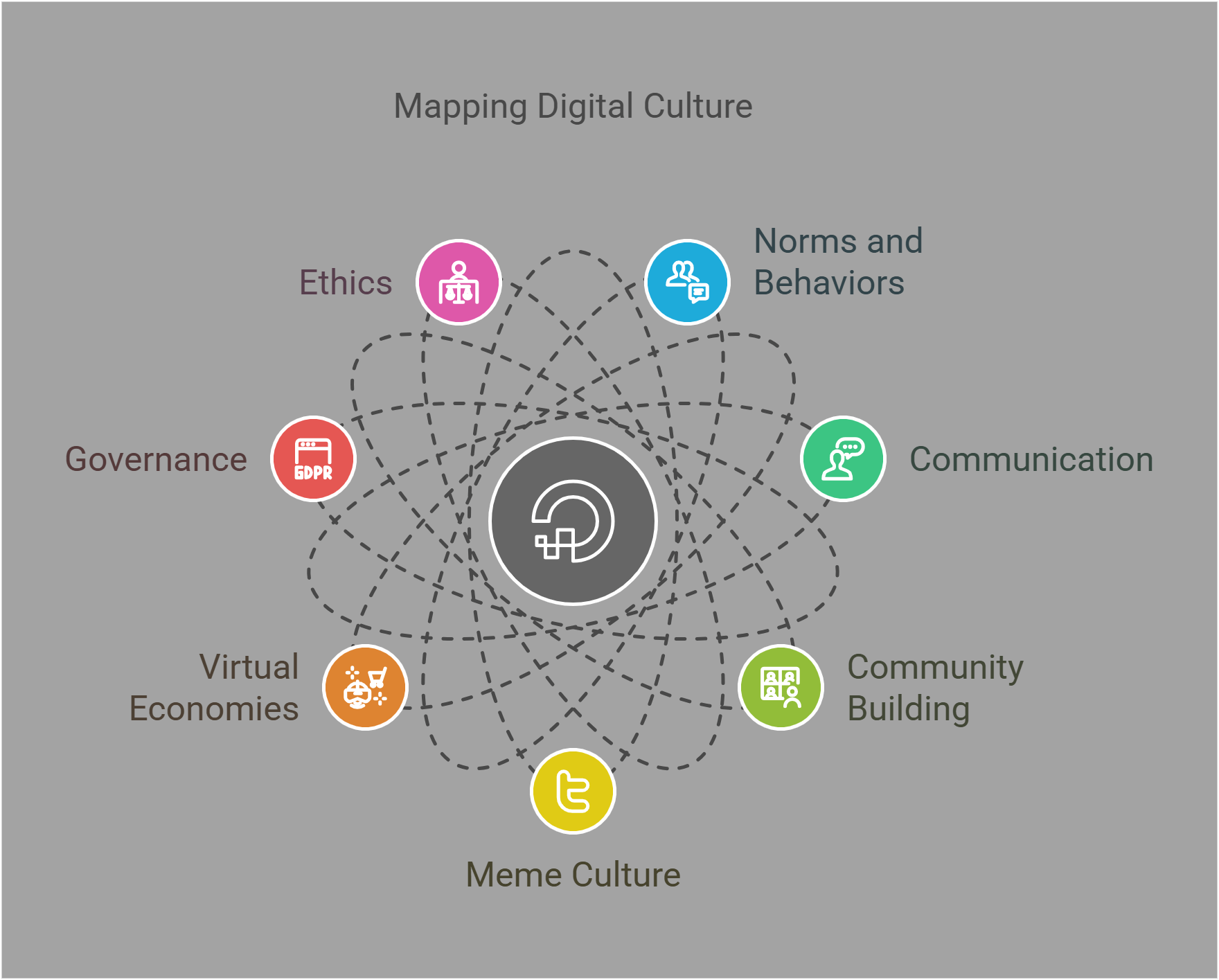
🔑 Key Concepts
This guide explores the following essential concepts in digital culture:
- Meme Culture
- Virtual Reality Communities
- Influencer Economy
- Cyberbullying
- Internet Governance
- Digital Privacy
- Online Activism
- Digital Nomadism
- Virtual Economies
- Ethics of AI-Generated Content
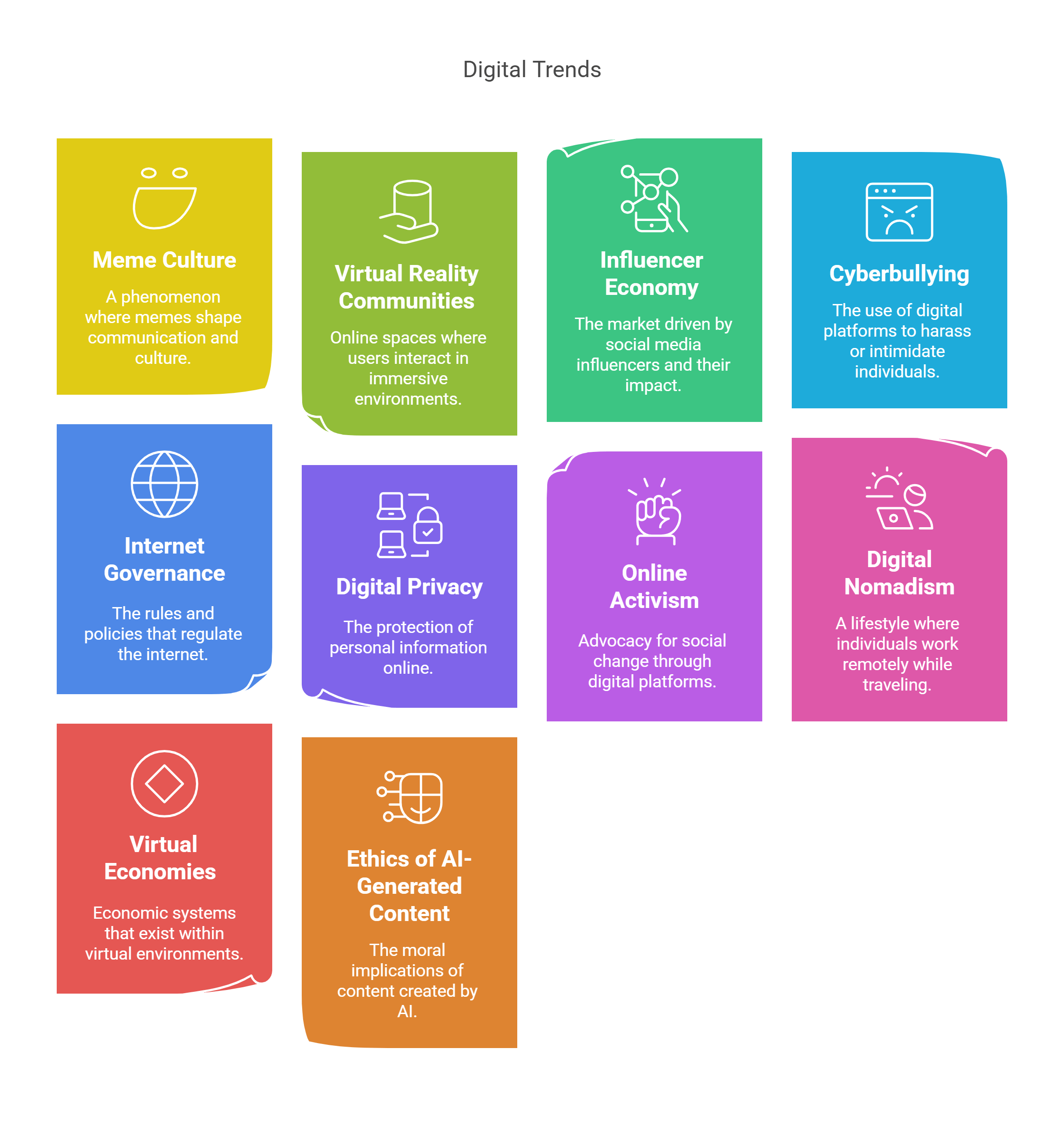
🔍 Detailed Explanations
1. Meme Culture
Meme culture revolves around the creation, sharing, and adaptation of memes—humorous, satirical, or thought-provoking content that spreads rapidly online.
Memes often comment on social issues, pop culture, or shared human experiences.
- Key Features:
- Visual Simplicity: Often images with captions or short videos.
- Rapid Evolution: Adapted and remixed to reflect changing contexts.
- Cultural Significance: Reflect collective moods, trends, or political sentiments.
- Impact:
- Serves as a tool for social critique and humor.
- Amplifies trends and ideas through virality.
- Risks perpetuating stereotypes or misinformation.
Example: The “Distracted Boyfriend” meme uses a single image to convey various humorous scenarios, showing the flexibility of meme formats.
Explained Simply: Meme culture is like the internet’s inside joke—constantly evolving and connecting people through shared humor.
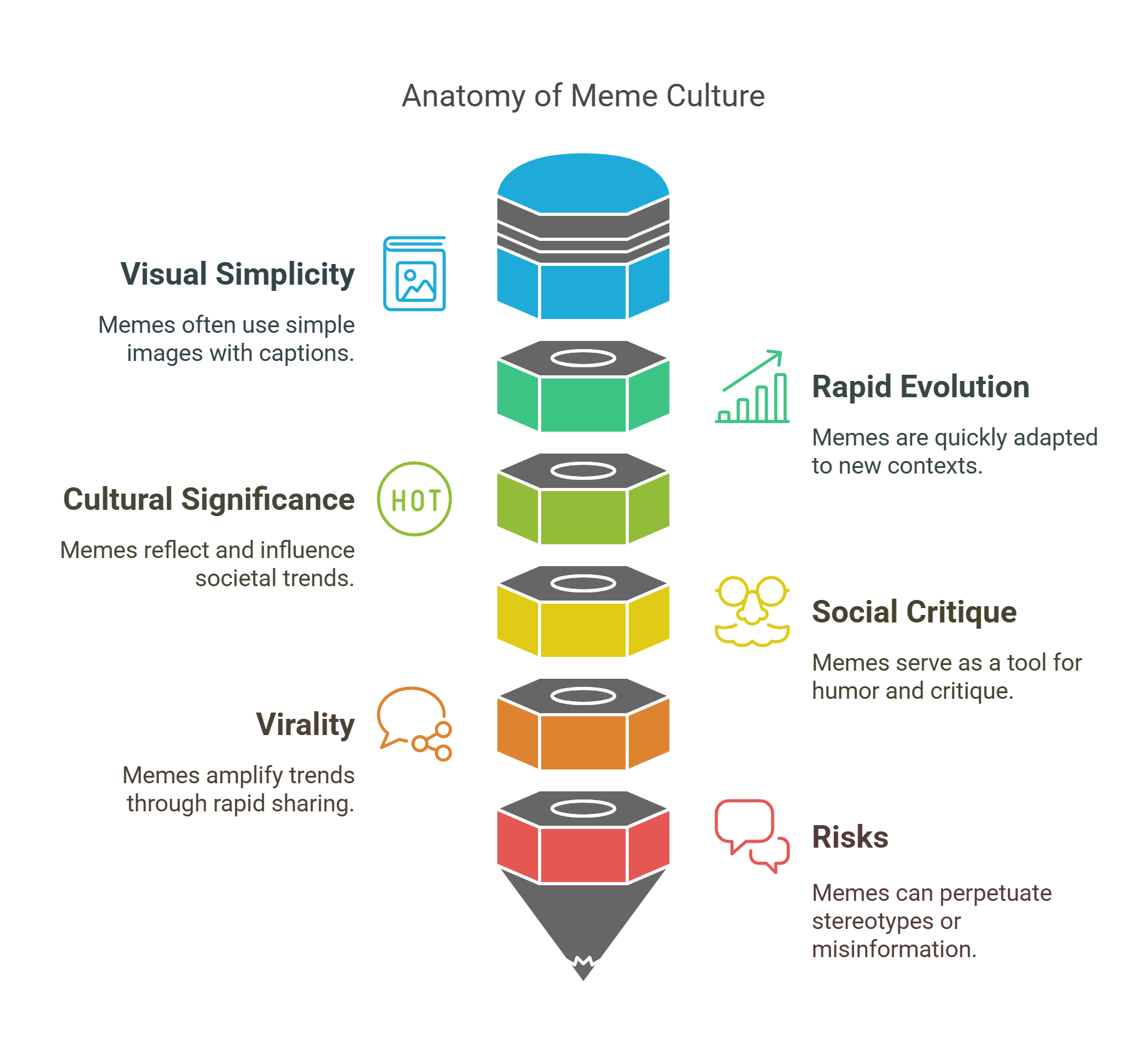
2. Virtual Reality Communities
Virtual reality (VR) communities are immersive online spaces where users interact through avatars in simulated environments.
These communities blend social interaction, gaming, and creativity.
- Key Platforms:
- Social VR: Platforms like VRChat and Meta Horizon Worlds.
- Gaming Communities: VR-based multiplayer games like Beat Saber and Rec Room.
- Applications:
- Enhances remote collaboration and training in workplaces.
- Fosters global connections in social and creative spaces.
- Challenges:
- Accessibility due to high costs of VR equipment.
- Potential for harassment or exclusion within virtual spaces.
Example: Virtual reality communities were used for social gatherings during the COVID-19 pandemic when physical meetings were restricted.
Explained Simply: VR communities are like stepping into a shared digital world where you can interact, create, and explore in new dimensions.
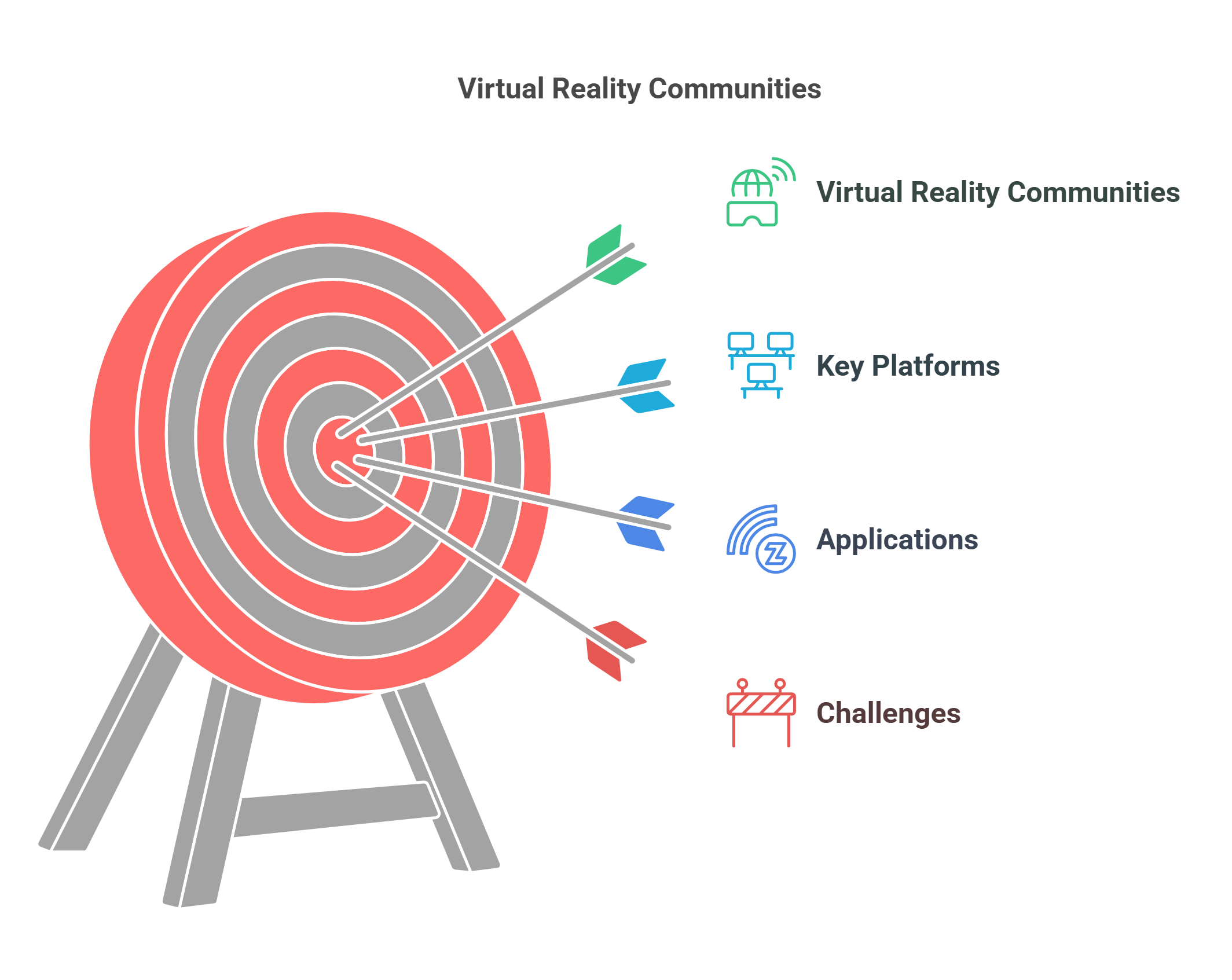
3. Influencer Economy
The influencer economy is built around individuals who leverage their social media presence to promote products, services, or ideas, often shaping consumer behavior and cultural trends.
- Key Features:
- Platforms: Instagram, TikTok, YouTube, and Twitch dominate the influencer space.
- Monetization: Through brand sponsorships, affiliate marketing, and merchandise sales.
- Micro-Influencers: Smaller followings but highly engaged audiences in niche markets.
- Impact:
- Influencers humanize brands and create personalized marketing experiences.
- Challenges traditional advertising by prioritizing authenticity and relatability.
- Challenges:
- Ethical concerns about transparency in sponsored content.
- The rise of influencer burnout due to constant content creation.
Example: Charli D’Amelio’s rise on TikTok demonstrates how influencers can quickly become cultural icons.
Explained Simply: The influencer economy is like word-of-mouth marketing on steroids, powered by likes, shares, and followers.
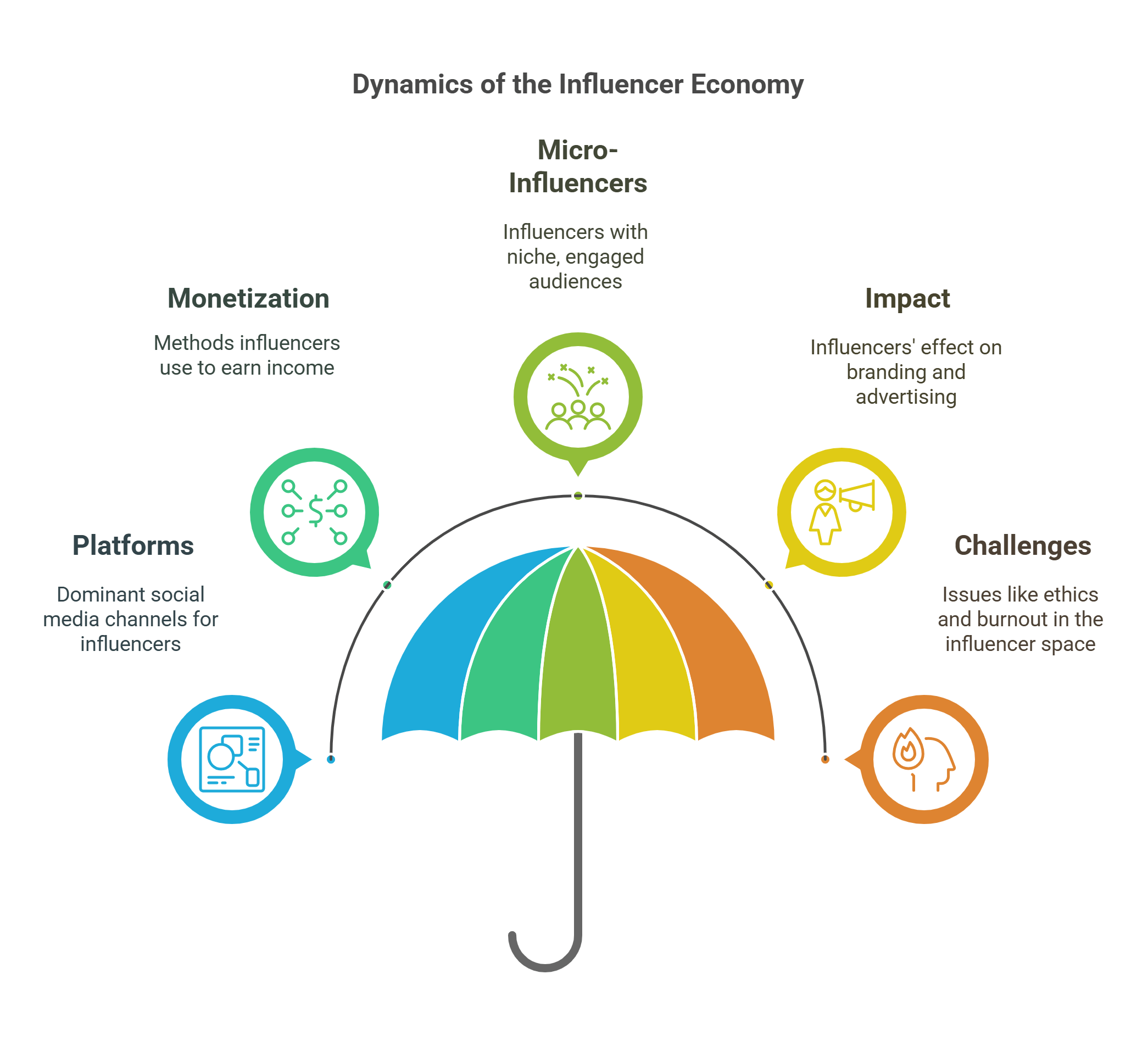
4. Cyberbullying
Cyberbullying involves using digital platforms to harass, threaten, or demean individuals. Unlike traditional bullying, it often extends beyond physical boundaries and reaches victims through their devices.
- Key Forms:
- Trolling: Posting inflammatory comments to provoke responses.
- Doxxing: Publishing private information online to intimidate or harm.
- Exclusion: Deliberately excluding someone from online groups or activities.
- Impact:
- Causes emotional distress, anxiety, and depression.
- Creates toxic online environments that discourage participation.
- Prevention and Response:
- Educating users about digital etiquette and empathy.
- Enforcing stricter platform policies and legal measures.
Example: Social media platforms like Instagram have introduced tools to detect and filter harmful comments.
Explained Simply: Cyberbullying is like being haunted by an invisible attacker, with harassment following victims wherever they go online.
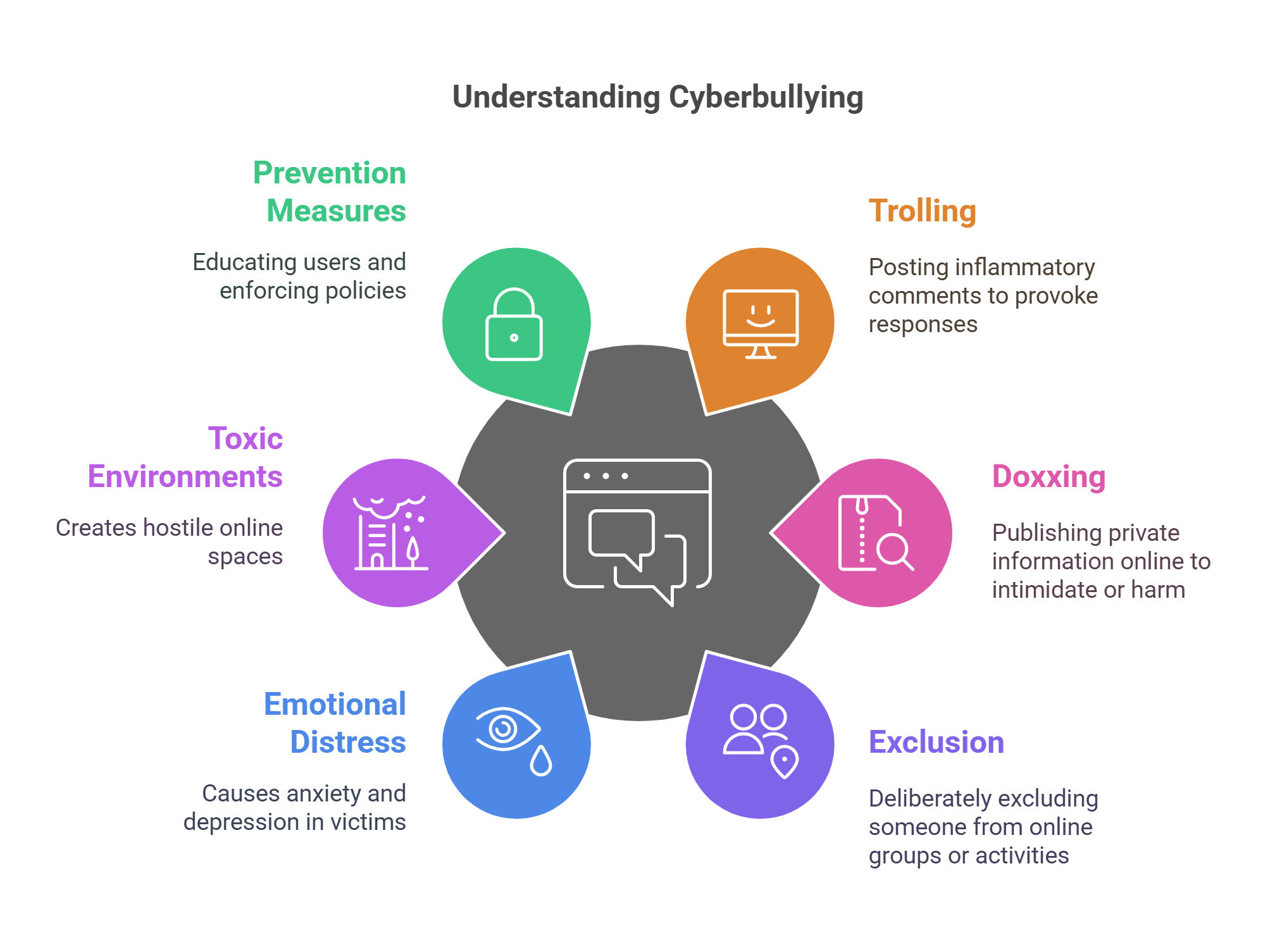
5. Internet Governance
Internet governance involves the policies, standards, and regulations that shape how the internet is managed, accessed, and used globally.
It addresses issues like data privacy, censorship, and digital equity.
- Key Stakeholders:
- Governments: Regulate access and content within borders.
- Tech Companies: Develop platforms and set usage policies.
- International Organizations: Promote collaboration (e.g., Internet Governance Forum).
- Challenges:
- Balancing free speech with preventing harmful content.
- Bridging the digital divide to ensure equitable internet access.
Example: Debates over net neutrality highlight the tension between corporate interests and equitable internet use.
Explained Simply: Internet governance is like managing a global highway, ensuring smooth traffic while preventing accidents and roadblocks.
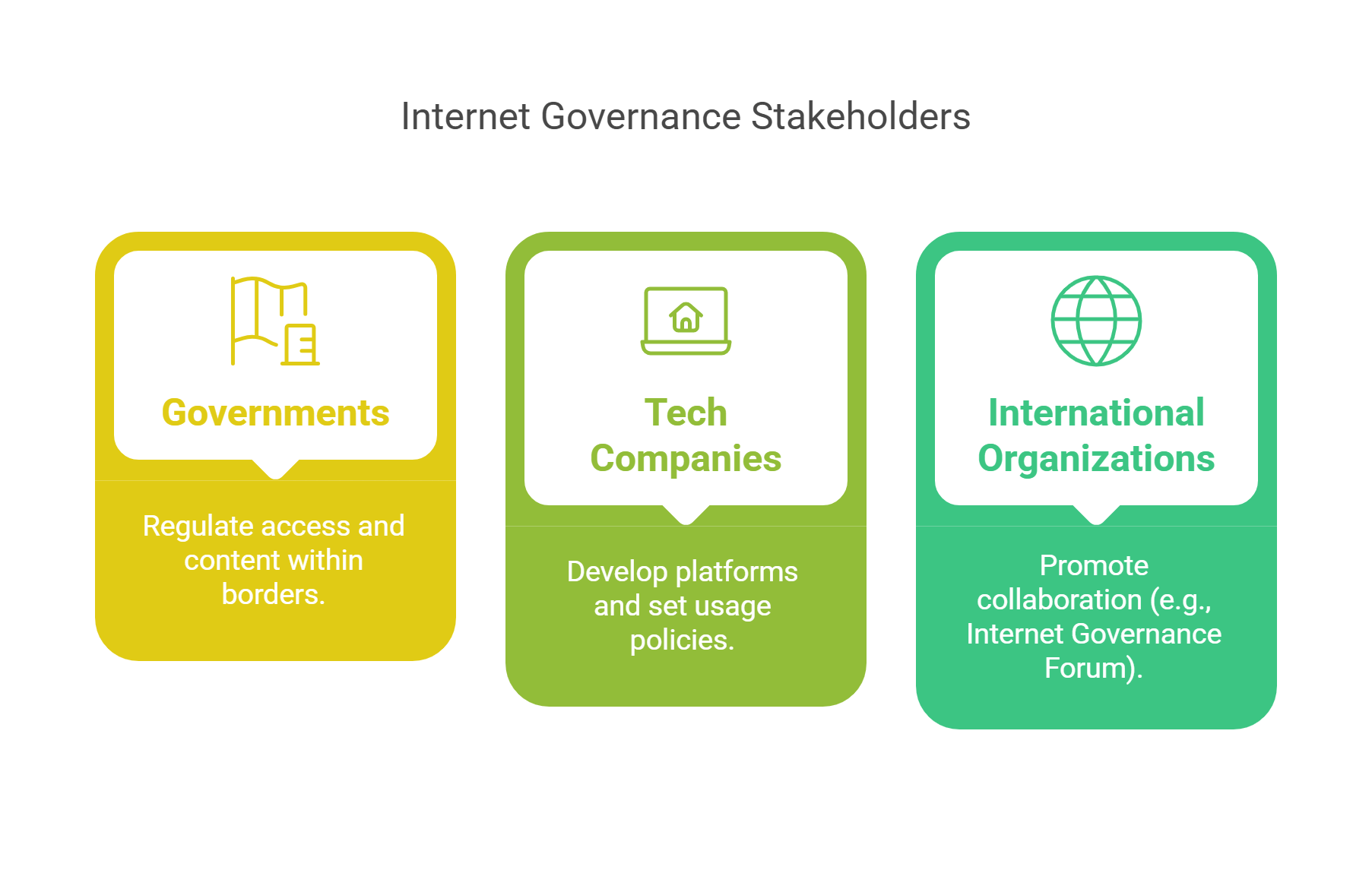
6. Digital Privacy
Digital privacy involves protecting personal information shared or stored online from unauthorized access, surveillance, or misuse.
With increasing data collection by businesses and governments, digital privacy has become a pressing concern in the digital age.
- Key Issues:
- Data Collection: Companies collect user data for targeted advertising or analytics.
- Surveillance: Governments monitor online activity for security, raising concerns about overreach.
- Data Breaches: Cyberattacks expose sensitive information, compromising user security.
- Legal Frameworks:
- General Data Protection Regulation (GDPR): Sets strict privacy rules in the European Union.
- California Consumer Privacy Act (CCPA): Provides privacy rights for California residents.
- Challenges:
- Educating users about protecting their digital footprint.
- Balancing privacy with business interests and national security.
Example: Apple’s App Tracking Transparency feature gives users control over data shared with apps.
Explained Simply: Digital privacy is like locking your digital house, ensuring only invited guests can enter.
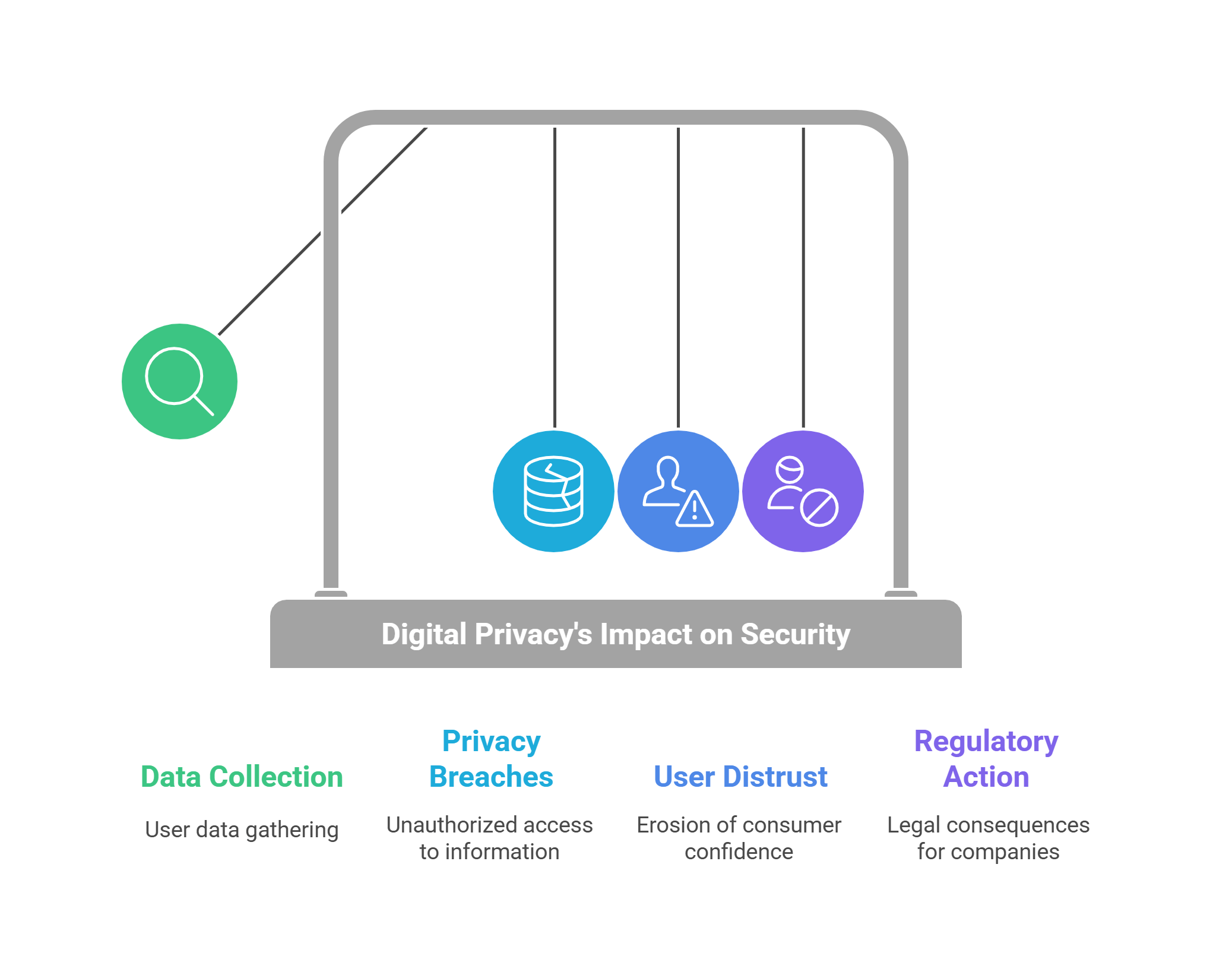
7. Online Activism
Online activism leverages digital platforms to mobilize support for social, political, or environmental causes.
It amplifies marginalized voices and facilitates global participation in advocacy.
- Key Forms:
- Hashtag Campaigns: Movements like #MeToo and #BlackLivesMatter gain momentum through social media.
- Petitions: Platforms like Change.org enable users to rally support for causes.
- Crowdfunding: Raises funds for projects or relief efforts through platforms like GoFundMe.
- Impact:
- Accelerates awareness and action on pressing issues.
- Provides a platform for grassroots organizations and individuals.
- Challenges:
- Risks of misinformation or performative activism (slacktivism).
- Censorship or surveillance in authoritarian regimes.
Example: Greta Thunberg’s climate strikes gained international attention through digital platforms.
Explained Simply: Online activism is like taking protests to the digital streets, making it easier to rally people worldwide.
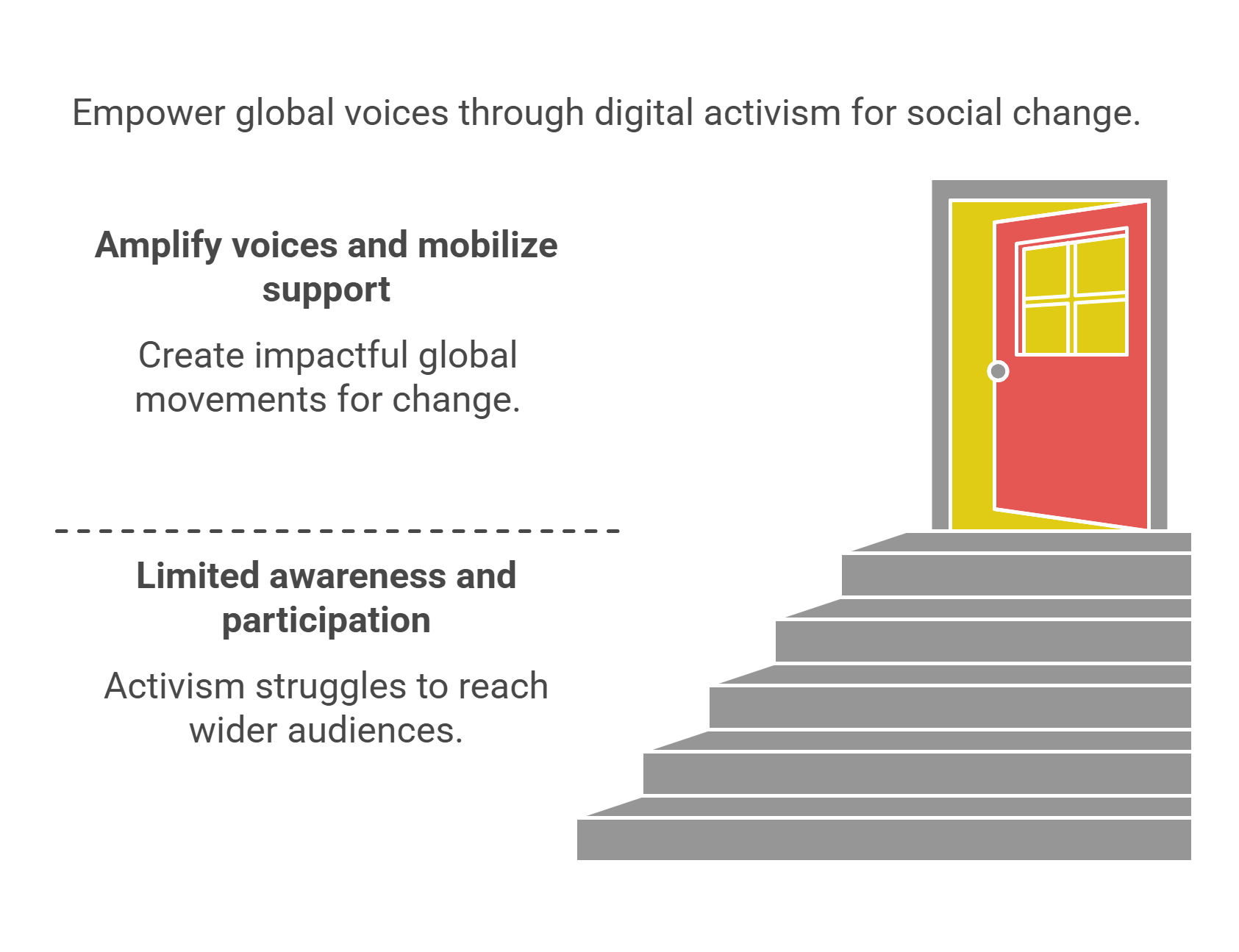
8. Digital Nomadism
Digital nomadism refers to a lifestyle where individuals work remotely while traveling, enabled by digital technologies like laptops, cloud services, and collaborative tools.
- Key Features:
- Flexibility: Nomads can work from anywhere with an internet connection.
- Popular Jobs: Freelancing, content creation, and remote programming.
- Coworking Spaces: Provide infrastructure and community for remote workers.
- Benefits:
- Combines work and travel, enhancing personal freedom.
- Reduces commuting costs and environmental impact.
- Challenges:
- Maintaining work-life balance in unfamiliar settings.
- Navigating visa restrictions and tax regulations.
Example: Bali, Indonesia, has become a hotspot for digital nomads due to affordable living costs and strong internet infrastructure.
Explained Simply: Digital nomadism is like working with your office in your backpack, wherever you choose to go.
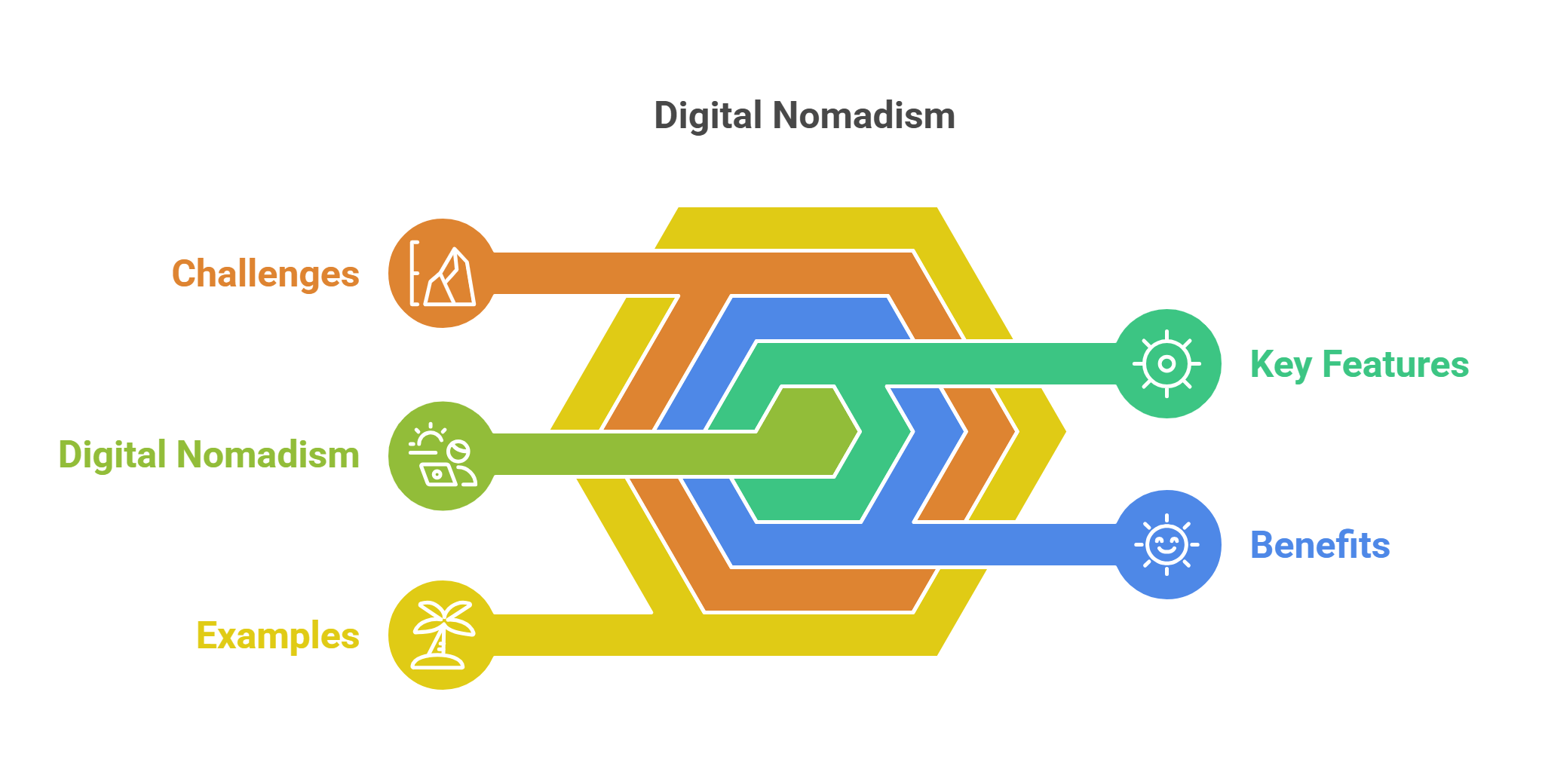
9. Virtual Economies
Virtual economies refer to digital marketplaces within online platforms where virtual goods and currencies are bought, sold, or traded.
These economies are often integral to gaming and virtual worlds.
- Key Features:
- In-Game Currencies: Such as V-Bucks in Fortnite or gold in World of Warcraft.
- Virtual Goods: Skins, avatars, or NFTs (non-fungible tokens) that hold real-world value.
- Real Money Trading (RMT): Converting virtual assets into real-world currency.
- Impact:
- Generates significant revenue for game developers and virtual platforms.
- Raises questions about digital ownership and regulation.
- Challenges:
- Exploitation through scams or unregulated trading.
- Ethical concerns about virtual economies fostering addictive behavior.
Example: Roblox’s virtual economy allows users to earn real money by creating and selling in-game items.
Explained Simply: Virtual economies are like digital marketplaces where creativity and commerce intersect.
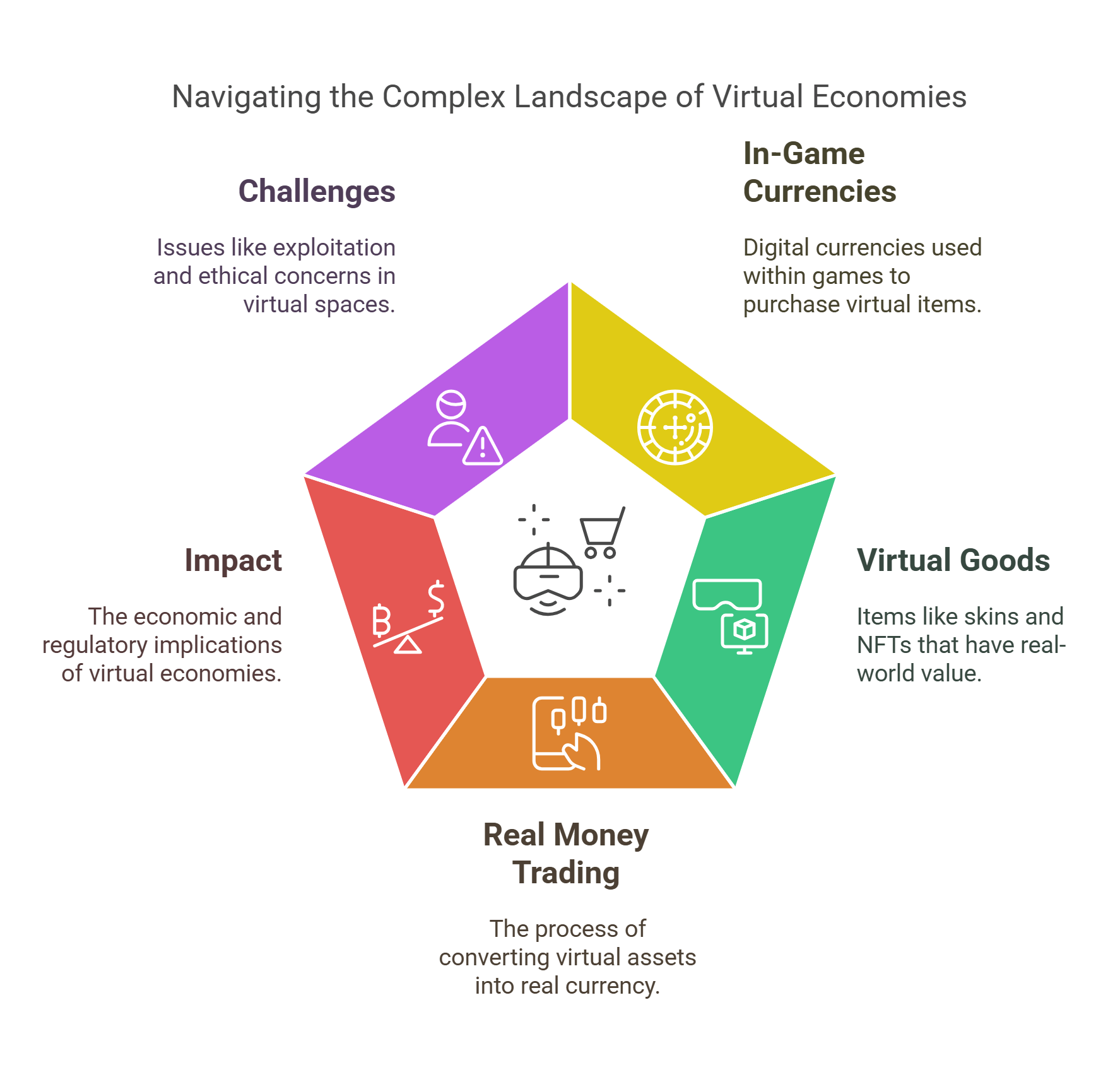
10. Ethics of AI-Generated Content
AI-generated content refers to text, images, videos, or music created by artificial intelligence systems, such as ChatGPT or DALL·E.
While these technologies enhance creativity and efficiency, they raise ethical questions.
- Key Ethical Concerns:
- Ownership: Who owns AI-generated work—the user, the developer, or the AI itself?
- Authenticity: Risks of deepfakes or fake news misleading the public.
- Job Displacement: Automated content creation threatening creative industries.
- Applications:
- Content marketing, video editing, and personalized storytelling.
- Virtual influencers and AI-driven entertainment.
- Challenges:
- Ensuring transparency about AI involvement in content creation.
- Preventing misuse for malicious purposes, such as fraud or misinformation.
Example: Deepfake videos have sparked debates on the ethical boundaries of AI in media.
Explained Simply: AI-generated content is like having a robot artist, but ethical dilemmas arise about how far this tool should go.
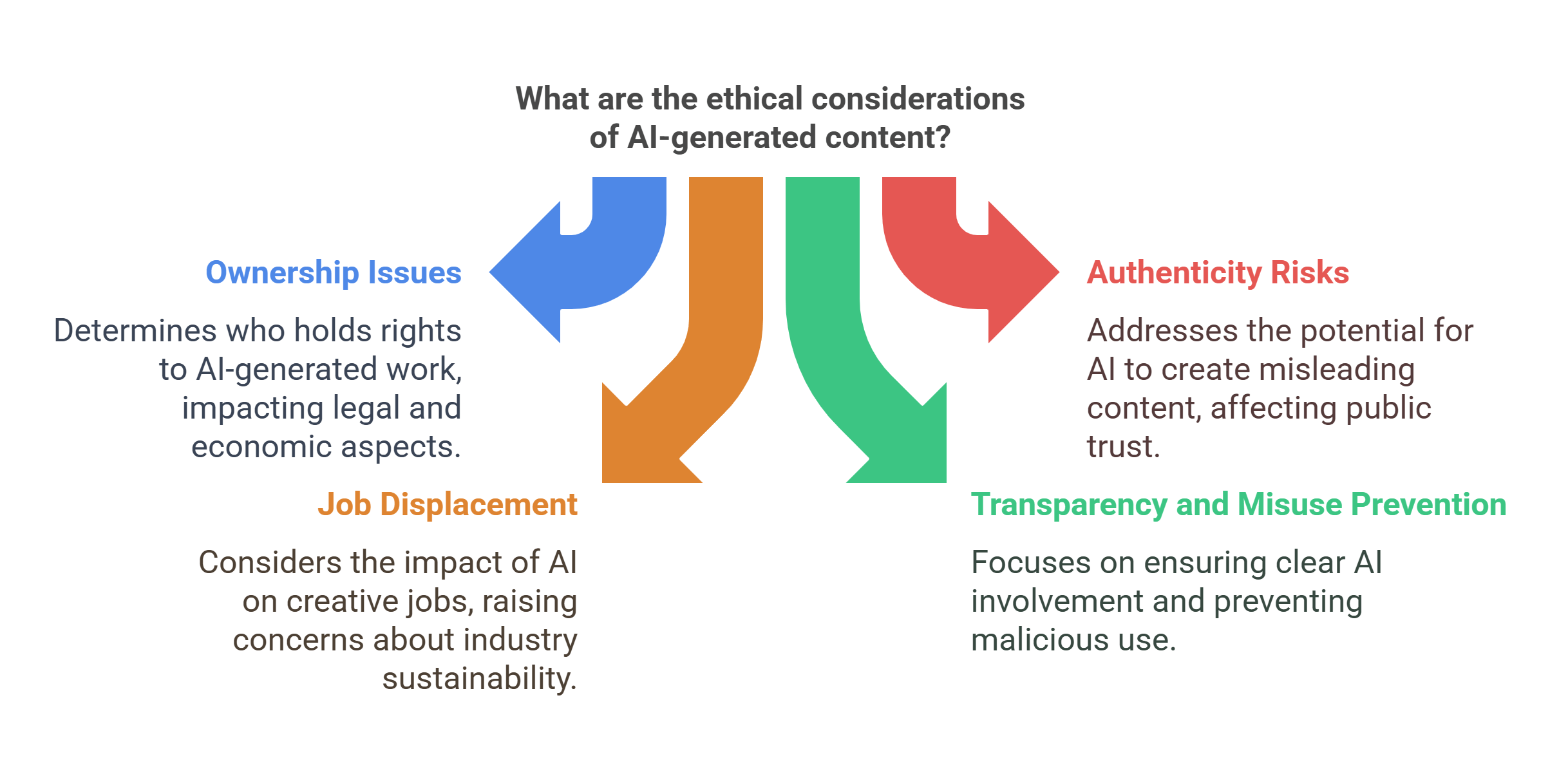
✨ Conclusion
Digital culture reflects the profound ways technology reshapes communication, creativity, and societal norms.
By exploring concepts like meme culture, online activism, and the ethics of AI-generated content, readers can critically analyze RC passages
and appreciate the complexity of life in the digital age.










